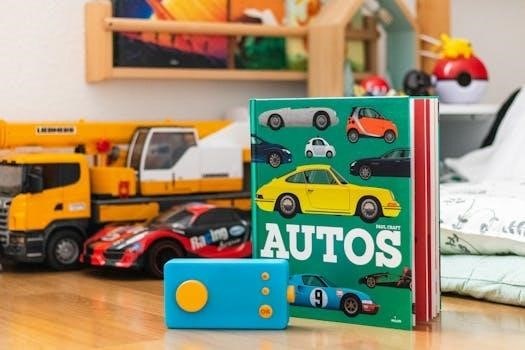
Exploring the enchanting realm of miniature worlds offers a unique and fulfilling hobby. Scaling down life into tiny forms requires skill, creativity, and precision. This manual guides you through creating your own captivating miniature scenes, providing essential tips and techniques to elevate your projects.
What ‘My Miniature Life’ Represents
“My Miniature Life” embodies the art of recreating life’s beautiful moments in a scaled-down format. It’s about more than just building small things; it’s about crafting tiny worlds that reflect our creativity and imagination. This hobby allows us to capture something more than just life, striving for realism and beauty in miniature forms. It represents a space where we can personalize our surroundings, creating engaging and entertaining scenes with depth. It’s a relaxing yet engaging experience where every choice shapes the story, offering a unique blend of creativity and precision. It’s not just about the objects, but also the joy of slowing down, focusing on detail, and finding happiness in the cute, small things. It also represents a community that loves to share wisdom and knowledge, learning from each other’s experiences. From dollhouse tutorials to miniature photography, it’s a world of endless possibilities.

Creating Miniature Worlds
Building miniature scenes requires careful planning and execution. From sourcing unique elements to arranging layouts, each step contributes to the overall realism. Explore different materials and techniques to bring your vision to life with stunning results.
Essential Tips for Miniature Photography
Capturing the essence of your miniature worlds through photography is key to sharing their beauty. When photographing your miniature scenes, strive to capture something more than just a simple snapshot, aim to create art. Start with simple backgrounds like walls or windows, these allow your miniature scene to shine. Focus on lighting, natural or artificial, to enhance the depth and details. Experiment with different angles and perspectives to find the most compelling view of your scene. Consider using a tripod to ensure stability and sharpness in your photos. Don’t be afraid to adjust the focus to highlight certain elements, creating an engaging image. Using a macro lens can help to capture the intricate details of your miniatures. Finally, patience is key; take your time to get the perfect shot. Remember that the goal is to make your miniature world feel life-size.
Tips for Building Miniature Scenes
Creating captivating miniature scenes involves careful planning and execution. Begin by choosing a theme that excites you, whether it’s fantasy, historical, or everyday life. Next, source your materials, exploring affordable options like 3D printed miniatures or everyday objects that can be repurposed. Plan your layout before assembly, sketching your ideas or using a computer program. Consider the scale you want to work with, ensuring that all elements are proportional. Start with the background and then move onto adding the smaller details. Use different textures to bring your scenes to life. When arranging figures, try different compositions to create a sense of movement. Take breaks, and dont rush the process. Pay close attention to details, such as colors and patterns. By following these tips, you can create a beautiful and immersive miniature world.

Miniature Painting Techniques
Painting your miniatures is crucial for bringing them to life. Proper surface preparation with cleaning and priming ensures good paint adhesion. A wet palette keeps your paints from drying, extending their lifespan, and improving your results.
Wet Palette and Paint Management
A wet palette is essential for miniature painting, acting as a sealed container with a water layer beneath permeable paper. This moisture prevents your paints from drying out, extending their usability and saving valuable resources. Using a wet palette provides a smoother consistency to your paints, making them easier to apply to miniatures. This is particularly helpful when working on intricate details, as it prevents the paint from becoming too thick or gloppy. Proper paint management also involves understanding the properties of different paints, such as acrylics, enamels, and oils. Knowing how each type behaves will help you achieve the desired finish on your miniatures. Experiment with different thinning mediums to adjust your paint consistency, achieving smooth transitions, and avoiding thick layers that can obscure fine details. Remember, patience and practice are key to mastering paint management and creating stunning results. Keeping your painting area organized and clean, with dedicated containers and tools will help enhance your overall experience.

Miniature Life Management
Balancing the captivating world of miniatures with real-life responsibilities requires mindful planning. Integrating your hobby into your routine ensures a fulfilling experience without neglecting other important aspects of your life, such as work, relationships, and relaxation.
Balancing Miniature Hobby with Real Life
Integrating a miniature hobby into your daily routine requires careful planning and a balanced approach. It’s crucial to avoid letting this captivating pastime consume all your time. Start by establishing dedicated time slots for your miniature projects, ensuring they don’t interfere with work, family, or social commitments. A simple folding table can serve as a dedicated miniature painting station, allowing you to leave your work in progress without constant packing. It’s equally essential to maintain a life outside of miniatures. Explore different activities to unlock surprises and maintain a healthy balance between hobbies and real-life obligations. Remember, staying motivated also means having time for other interests, which in turn will help you enjoy your miniature creations even more. Consider your financial goals too, and ensure your miniature hobby aligns with your financial comfort. By slowing down and being intentional, you will produce better results and have more fun in the process. It is also important to remember that the hobby is more enjoyable when it is not the only thing in your life.

Specific Miniature Types
Delving into specific miniature types reveals the diverse nature of this hobby. From beloved pets to detailed scenes, each type offers its unique challenges and rewards. This section explores specific miniature examples, like miniature poodles and goldendoodles.
Miniature Poodle Characteristics
Miniature Poodles are renowned for their loving, playful, and energetic personalities, making them fantastic companions. They thrive on human interaction and develop strong bonds with their families. These intelligent dogs are family-friendly and enjoy being part of a pack. Miniature Poodles can become anxious if left alone for long periods; therefore, they are best suited to owners who can provide the attention and love they need. Their need for interaction and affection should be considered when thinking about a miniature poodle. They are not simply decorative, but living beings. Their energy levels means that they need regular interaction and exercise. Also, they are not just dogs, they are family members who want to be treated as part of the family. So, keep that in mind; They are very social creatures and they thrive on attention.
Miniature Goldendoodle Puppy Care
Miniature Goldendoodle puppies, a delightful mix of Golden Retriever and Miniature Poodle, require dedicated care. Their friendly nature, hypoallergenic coats, and manageable size make them ideal companions. Proper nutrition is crucial for their health and development, with specific dietary needs for puppies. Transportation should be stress-free, using safe and comfortable methods. Training is essential, utilizing positive reinforcement to leverage their intelligence and eagerness to please. A consistent routine for feeding, exercise, training, and bedtime is vital for their security and well-being. Early detection and proper care are also vital for their quality of life. Remember that raising a Mini Goldendoodle puppy is a rewarding journey, demanding attentiveness to their unique needs and a commitment to building a loving bond with your furry friend. Always remember that they are not just a dog, they are a member of the family.